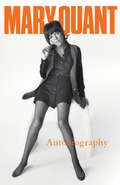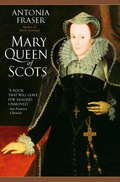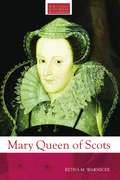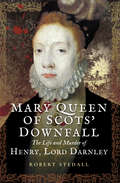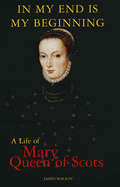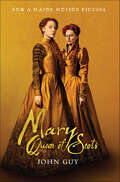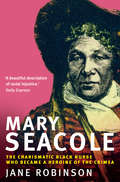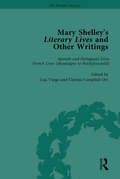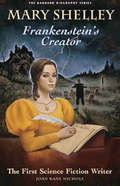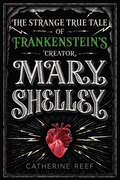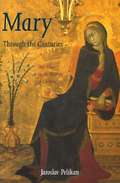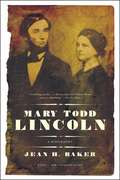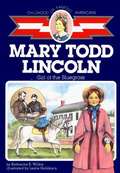- Table View
- List View
Mary Quant: My Autobiography
by Mary QuantMary Quant defined the 60s as a renowned fashion designer and all-round style icon, most famous for inventing the miniskirt and hot pants. Not afraid of novelty or experimentation, she showed a generation of women how to dress to please themselves. Quant's career was fulsome and varied - from opening up a clothes shop on the King's Road called Bazaar, designing the interior of the Mini (including her signature daisy), to her vast cosmetics company, Mary Quant Limited, she has widespread appeal to generations of women. In her autobiography, Mary combines the inspirational story of a stellar career with the touching personal story of her life with the man she loved, Alexander Plunkett-Green and her role of mother to their son, Orlando. Mary Quant gives us a glimpse of the real women behind the icon.
Mary Quant: My Autobiography
by Mary QuantMary Quant defined the 60s as a renowned fashion designer and all-round style icon, most famous for inventing the miniskirt and hot pants. Not afraid of novelty or experimentation, she showed a generation of women how to dress to please themselves. Quant's career was fulsome and varied - from opening up a clothes shop on the King's Road called Bazaar, designing the interior of the Mini (including her signature daisy), to her vast cosmetics company, Mary Quant Limited, she has widespread appeal to generations of women. In her autobiography, Mary combines the inspirational story of a stellar career with the touching personal story of her life with the man she loved, Alexander Plunkett-Green and her role of mother to their son, Orlando. Mary Quant gives us a glimpse of the real women behind the icon.
Mary Queen Of Scots
by Antonia Fraser'Ground-breaking ... One of the greatest international bestsellers of the post-war period' Andrew Roberts, Daily Telegraph'Reads like an engrossing novel' Sunday TimesAn infant queen. A teenage widow. Beautiful, flamboyant Mary Queen of Scots had a formidable intellect but her political sense - formed at the absolute court of France - plunged her country into a maelstrom of intrigue, marriage and murder. Upon fleeing to England she was held captive by her cousin Elizabeth I. In this classic biography, reissued for the fiftieth anniversary of its publication, acclaimed historian Antonia Fraser relates the enthralling story of Mary's life and untimely end.
Mary Queen Of Scots
by Lady Antonia FraserMary Queen of Scots passed her childhood in France and married the Dauphin to become Queen of France at the age of sixteen. Widowed less than two years later, she returned to Scotland as Queen after an absence of thirteen years.Her life then entered its best known phase: the early struggles with John Knox, and the unruly Scottish nobility; the fatal marriage to Darnley and his mysterious death; her marriage to Bothwell, the chief suspect, that led directly to her long English captivity at the hands of Queen Elizabeth; the poignant and extraordinary story of her long imprisonment that ended with the labyrinthine Babington plot to free her, and her execution at the age of forty-four.Read by Patricia Hodge(p) 2002 Orion Publishing Group
Mary Queen of Scots
by Antonia FraserShe was the quintessential queen: statuesque, regal, dazzlingly beautiful. Her royal birth gave her claim to the thrones of two nations; her marriage to the young French dauphin promised to place a third glorious crown on her noble head.<P> Instead, Mary Stuart became the victim of her own impulsive heart, scandalizing her world with a foolish passion that would lead to abduction, rape and even murder. Betrayed by those she most trusted, she would be lured into a deadly game of power, only to lose to her envious and unforgiving cousin, Elizabeth I. Here is her story, a queen who lost a throne for love, a monarch pampered and adored even as she was led to her beheading, the unforgettable woman who became a legend for all time.
Mary Queen of Scots
by Antonia FraserMary Queen of Scots passed her childhood in France and married the Dauphin to become Queen of France at the age of sixteen. Widowed less than two years later, she returned to Scotland as Queen after an absence of thirteen years.
Mary Queen of Scots (Routledge Historical Biographies)
by Retha M. Warnicke"Scholars now have Warnicke to use as their chief one volume study of Mary" Julian Goodare, University of Edinburgh In this biography of one of the most intriguing figures of early modern European history, Retha Warnicke, widely regarded as a leading historian on Tudor queenship, offers a fresh interpretation of the life of Mary Stuart, popularly known as Mary Queen of Scots. Setting Mary's life within the context of the cultural and intellectual climate of the time and bringing to life the realities of being a female monarch in the sixteenth century, Warnicke also examines Mary's three marriages, her constant ill health and her role in numerous plots and conspiracies. Placing Mary within the context of early modern gender relations, Warnicke reveals the challenges that faced her and the forces that worked to destroy her. This highly readable and fascinating study will pour fresh light on the much-debated life of a central figure of the sixteenth century, providing a new interpretation of Mary Stuart's impact on politics, gender and nationhood in the Tudor era.
Mary Queen of Scots' Downfall: The Life and Murder of Henry, Lord Darnley
by Robert StedallThe story of the Scottish ruler—and the mysterious death of her ambitious and controversial husband. In the early hours of February 10, 1567, a large explosion ripped through the lodgings at Kirk o&’ Field, Edinburgh, where Mary Queen of Scotland&’s consort, Henry, Lord Darnley, was staying. Darnley&’s body was found with that of his valet in a neighboring garden the next morning. The queen&’s husband had been murdered—and the ramifications for Mary and Scottish history would be far-reaching. Lord Darnley cuts an infamous figure in Scottish and Tudor history. In life, he proved a controversial character, and his murder at Kirk o&’ Field remains one of British history&’s great unsolved mysteries—the question of whether Mary was implicated has taxed historians ever since. In this engaging and well-researched biography, Robert Stedall reexamines Darnley&’s life and his death. His investigation brings new light and compelling conclusions to a story surrounded by political betrayal, murder, falsified evidence, and conspiracy.
Mary Queen of Scots' Secretary: William Maitland—Politician, Reformer and Conspirator
by Robert Stedall“It’s as good as a Philippa Gregory, and tells you so much more about Mary Queen of Scots and the people with whom she surrounded herself.” —Books MonthlyWilliam Maitland of Lethington was the most able politician and diplomat during the lifetime of Mary Queen of Scots. It was he who masterminded the Scottish Reformation by breaking the ‘Auld Alliance’ with France, which presaged Scotland’s lasting union with England.Although he gained English support to defeat French troops defending Mary’s Scottish throne, he backed her return to Scotland, as the widowed Queen of France. His attempts to gain recognition for her as heir to the English crown were thwarted by her determined adherence to Catholicism.After her remarriage, he spearheaded the plotting to bring down her objectionable husband, Lord Darnley, leading to his murder, after concluding that English and Scottish interests were best served by creating a Protestant regency for their son, Prince James. With encouragement from Cecil in England and the Protestant Lords in Scotland, he concocted evidence to implicate her in her husband’s murder, resulting in her imprisonment and deposition from the Scottish throne.This is the thrilling biography of a complicated man whose loyalty wavered between queen and country and whose behind-the-throne machinations may have caused her undoing—and his own . . . “A modern, convincing—I must also use that popular buzzword ‘game-changing’—biography that combines page-turning narrative with convincing, sophisticated, scholarly argument.” —Steven Veerapen, Professor of History, Strathclyde University
Mary Queen of Scots: In My End is My Beginning
by Dr James MackayIn My End Is My Beginning is the story of Mary Queen of Scots (1542–87), the tragic heroine par excellence. Queen of an unfamiliar and troubled nation when she was a week old, it was her misfortune to be a pawn in the game of international politics throughout her life. Even in the brief period from 1561 to 1567 when she was ruler of Scotland in fact as well as in name, she was beset with problems that would have defeated a much stronger, more experienced monarch. A talented poet and a charismatic leader, she contended with a treacherous, self-serving nobility, the religious ferment of the Reformation, and the political ambitions of larger and more powerful neighbours. With little real authority and few resources, Mary’s reign was successful, until her disastrous marriage to the dissolute Darnley set in motion the events that brought about her downfall. For the last 20 years of her life she was a prisoner in the hands of her cousin, Elizabeth I of England, and the subject of treacherous plots and conspiracies. A hostage to fortune, she represented a threat and a rallying-point for English Catholics. Her tragic end was inevitable. Yet her life, with all its adventurous, failures and disasters, produced the son – James – who ultimately brought about the union of Scotland and England.In the End Is My Beginning uncovers the true facts of Mary’s life in the context of Anglo-Scottish relations and shows why, after more than 400 years, she remains arguably the greatest character in popular Scottish history.
Mary Queen of Scots: The True Life Of Mary Stuart (Cambridge Studies In Early Modern British History Ser.)
by John GuyNOW A MAJOR MOTION PICTURE starring Saoirse Ronan and Margot Robbie. A biography "as enthralling as a detective story," of the woman who reigned over sixteenth-century Scotland (New York Times Book Review).In Mary Queen of Scots, John Guy creates an intimate and absorbing portrait of one of history’s most famous women, depicting her world and her place in the sweep of history with stunning immediacy. Bringing together all surviving documents and uncovering a trove of new sources for the first time, Guy dispels the popular image of Mary Stuart as a romantic leading lady—achieving her ends through feminine wiles—and establishes her as the intellectual and political equal of Elizabeth I. Through Guy’s pioneering research and superbly readable prose, we come to see Mary as a skillful diplomat, maneuvering ingeniously among a dizzying array of factions that sought to control or dethrone her. It is an enthralling, myth-shattering look at a complex woman and ruler and her time. “The definitive biography . . . gripping . . . a pure pleasure to read.”—Washington Post Book WorldFirst published in 2004 as Queen of Scots
Mary Seacole: The Charismatic Black Nurse Who Became a Heroine of the Crimea
by Jane RobinsonThe 'Greatest Black Briton in History' triumphed over the Crimea and Victorian England. "The Times" called her a heroine, Florence Nightingale called her a brothel-keeping quack, and Queen Victoria's nephew called her, simply, 'Mammy' - Mary Seacole was one of the most eccentric and charismatic women of her era. Born at her mother's hotel in Jamaica in 1805, she became an independent 'doctress' combining the herbal remedies of her African ancestry with sound surgical techniques. On the outbreak of the Crimean War, she arrived in London desperate to join Florence Nightingale at the Front, but the authorities refused to see her. Being black, nearly 50, rather stout, and gloriously loud in every way, she was obviously unsuitable. Undaunted, Mary travelled to Balaklava under her own steam to build the 'British Hotel', just behind the lines. It was an outrageous venture, and a huge success - she became known and loved by everyone from the rank and file to the royal family. For more than a century after her death this remarkable woman was all but forgotten. This, the first full-length biography of a Victorian celebrity recently voted the greatest black Briton in history, brings Mary Seacole centre stage at last.
Mary Seacole: The Charismatic Black Nurse Who Became a Heroine of the Crimea
by Jane RobinsonThe 'Greatest Black Briton in History' triumphed over the Crimea and Victorian England. "The Times" called her a heroine, Florence Nightingale called her a brothel-keeping quack, and Queen Victoria's nephew called her, simply, 'Mammy' - Mary Seacole was one of the most eccentric and charismatic women of her era. Born at her mother's hotel in Jamaica in 1805, she became an independent 'doctress' combining the herbal remedies of her African ancestry with sound surgical techniques. On the outbreak of the Crimean War, she arrived in London desperate to join Florence Nightingale at the Front, but the authorities refused to see her. Being black, nearly 50, rather stout, and gloriously loud in every way, she was obviously unsuitable. Undaunted, Mary travelled to Balaklava under her own steam to build the 'British Hotel', just behind the lines. It was an outrageous venture, and a huge success - she became known and loved by everyone from the rank and file to the royal family. For more than a century after her death this remarkable woman was all but forgotten. This, the first full-length biography of a Victorian celebrity recently voted the greatest black Briton in history, brings Mary Seacole centre stage at last.
Mary Shelley's Literary Lives and Other Writings, Volume 2: Spanish And Portuguese Lives
by Lisa VargoThis collection covers the lyrical poetry of Mary Shelley, as well as her writings for Lardner's "Cabinet Cyclopaedia of Biography" and some other materials only recently attributed to her.
Mary Shelley, Frankenstein's Creator: First Science Fiction Writer
by Joan Kane NicholsA biography of the nineteenth-century English writer who at the age of nineteen wrote the classic horror novel "Frankenstein".
Mary Shelley: The Strange True Tale of Frankenstein's Creator
by Catherine ReefOn the 200th anniversary of the publication of Frankenstein, comes a riveting biography of its author, Mary Shelley, whose life reads like a dark gothic novel, filled with scandal, death, drama, and one of the strangest love stories in literary history. The story of Frankenstein&’s creator is a strange, romantic, and tragic one, as deeply compelling as the novel itself. Mary ran away to Lake Geneva with the poet Percy Bysshe Shelley when she was just sixteen. It was there, during a cold and wet summer, that she first imagined her story about a mad scientist who brought a corpse back to life. Success soon followed for Mary, but also great tragedy and misfortune. Catherine Reef brings this passionate woman, brilliant writer, and forgotten feminist into crisp focus, detailing a life that was remarkable both before and after the publication of her iconic masterpiece. Includes index.
Mary Somerville and the World of Science
by Allan ChapmanMary Somerville (1780-1872), after whom Somerville College Oxford was named, was the first woman scientist to win an international reputation entirely in her own right, rather than through association with a scientific brother or father. She was active in astronomy, one of the most demanding areas of science of the day, and flourished in the unique British tradition of Grand Amateurs, who paid their own way and were not affiliated with any academic institution. Mary Somerville was to science what Jane Austen was to literature and Frances Trollope to travel writing. Allan Chapman's vivid account brings to light the story of an exceptional woman, whose achievements in a field dominated by men deserve to be very widely known.
Mary Stuart
by Eden Paul Cedar Paul Stefan ZweigMary Stuart Queen of Scots, Queen of France and a claimant to the throne of England, was condemned for treason and executed at the age of forty-four. A potential threat to the stability of the English Crown, she was held captive for twenty years by her cousin Elizabeth I, Queen of England. From the moment of her birth until her execution, her life was spent embroiled in the power struggles that shook the foundations of Renaissance Europe.It has taken the free spirit and the immense talent of Stefan Zweig to justly reconstruct events in the life of a woman who was so cruelly united with destiny. With all the rigor of a scientist and the passion of an artist, Zweig has skillfully reconstituted the character of Mary Stuart and the turmoil that was her fate.
Mary The Queen (Mary Tudor #3)
by Hilda LewisIt is more than a year since I put by my pen; a hard year. But God has given me courage to meet it, and has seen good to make smooth my hard way. I, that was a poor, hunted, persecuted creature am now a hallowed Queen. And God has added blessing upon blessing so that I write now in such joy as woman never had. And if I depart by one hair's breadth from the truth, shall not a just God put it in the balance against me to outweight every blessing? So now I take up my pen again and go back in memory to that first night in the Tower when I was proclaimed; when in that same Tower lay my cousin Jane Grey, usurping Queen, those that had crowned her and many another traitor that would have had my life.
Mary Through the Centuries: Her Place in the History of Culture
by Jaroslav PelikanExamines all of Christian history & culture to create the most complete portrait of the Virgin Mary every written. Pelikan assesses the ways people throughout time & place have depicted, venerated, & been inspired by Mary.
Mary Todd Lincoln: A Biography
by Jean Harvey Baker"A complex and moving character study of a woman tragically out of step with her time and place."--Chicago Tribune This definitive biography of Mary Todd Lincoln beautifully conveys her tumultuous life and times. A privileged daughter of the proud clan that founded Lexington, Kentucky, Mary fell into a stormy romance with the raw Illinois attorney Abraham Lincoln. For twenty-five years the Lincolns forged opposing temperaments into a tolerant, loving marriage. Even as the nation suffered secession and civil war, Mary experienced the tragedies of losing three of her four children and then her husband. An insanity trial orchestrated by her surviving son led to her confinement in an asylum. Mary Todd Lincoln is still often portrayed in one dimension, as the stereotype of the best-hated faults of all women. Here her life is restored for us whole.
Mary Todd Lincoln: A Biography
by Jean M. BakerA privileged daughter of the proud clan that founded Lexington, Kentucky, Mary Todd (1818-1882) was raised in a world of frontier violence. Subjected to her first abandonment at age six when her mother died, Mary later fled a hostile stepmother for Springfield, where she met and, after a stormy romance, married the raw Illinois attorney, Abraham Lincoln. For twenty-five years the Lincolns forged opposing temperaments into a tolerant, loving marriage. Mary was at her husband's side on the night of his assassination, and never recovered from that greatest in a series of grievous abandonments. The desperate measures she took to win the acknowledgment she sought all her life led finally to the shock of a public insanity hearing instigated by her eldest son. In this elegant biography, Jean Baker uses previously untapped letters and documents to portray a woman whose will carried her across the recognized boundaries of female behavior.
Mary Todd Lincoln: Girl of the Bluegrass
by Katharine E. WilkieA biography concentrating on the childhood of the Kentucky girl who grew up to marry Abraham Lincoln.
Mary Tudor
by Anna WhitelockShe was the first woman to inherit the throne of England, a key player in one of Britain's stormiest eras, and a leader whose unwavering faith and swift retribution earned her the nickname "Bloody Mary." Now, in this impassioned and absorbing debut, historian Anna Whitelock offers a modern perspective on Mary Tudor and sets the record straight once and for all on one of history's most compelling and maligned rulers. Though often overshadowed by her long-reigning sister, Elizabeth I, Mary lived a life full of defiance, despair, and triumph. Born the daughter of the notorious King Henry VIII and the Spanish Katherine of Aragon, young Mary was a princess in every sense of the word--schooled in regal customs, educated by the best scholars, coveted by European royalty, and betrothed before she had reached the age of three. Yet in a decade's time, in the wake of King Henry's break with the pope, she was declared a bastard, disinherited, and demoted from "princess" to "lady." Ever her deeply devout mother's daughter, Mary refused to accept her new status or to recognize Henry's new wife, Anne Boleyn, as queen. The fallout with her father and his counselors nearly destroyed the teenage Mary, who faced imprisonment and even death. It would be an outright battle for Mary to work herself back into the king's favor, claim her rightful place in the Tudor line, and ultimately become queen of England, but her coronation would not end her struggles. She flouted the opposition and married Philip of Spain, sought to restore Catholicism to the nation, and fiercely punished the resistance. But beneath her brave and regal exterior was a dependent woman prone to anxiety, whose private traumas of phantom pregnancies, debilitating illnesses, and unrequited love played out in the public glare of the fickle court. Anna Whitelock, an acclaimed young British historian, chronicles this unique woman's life from her beginnings as a heralded princess to her rivalry with her sister to her ascent as ruler. In brilliant detail, Whitelock reveals that Mary Tudor was not the weak-willed failure as so often rendered by traditional narratives but a complex figure of immense courage, determination, and humanity.
